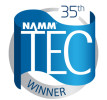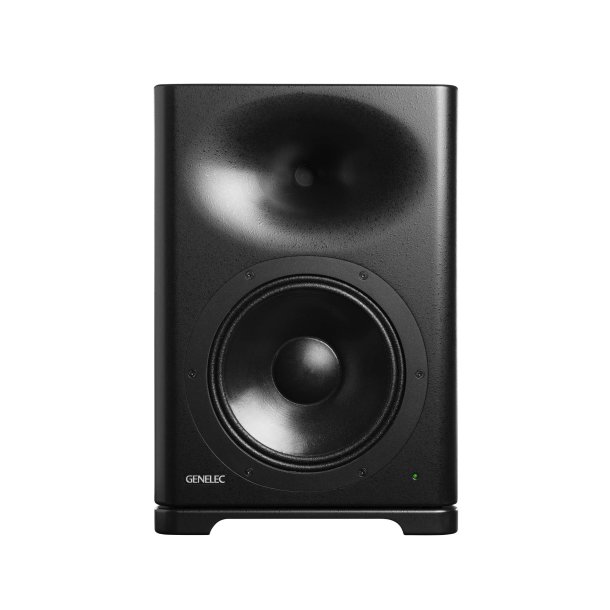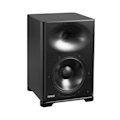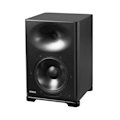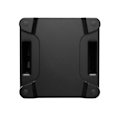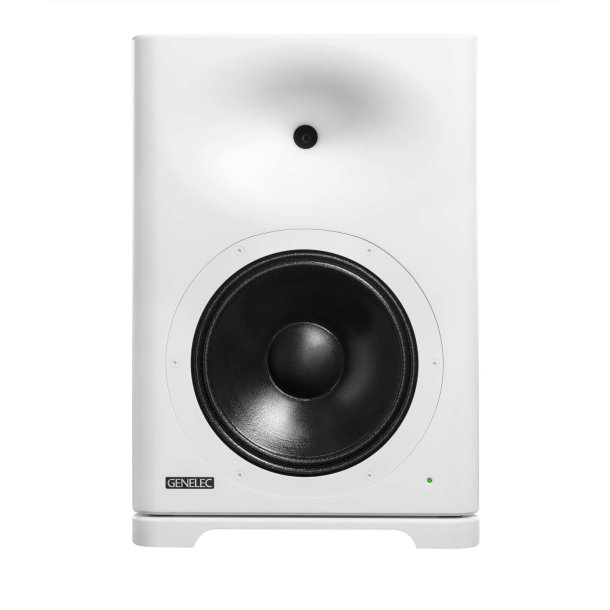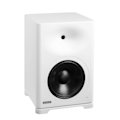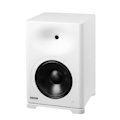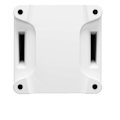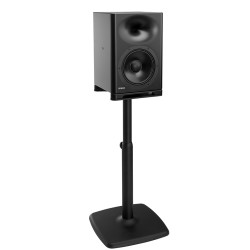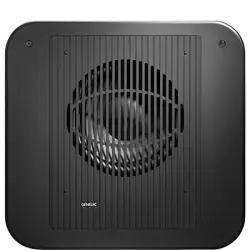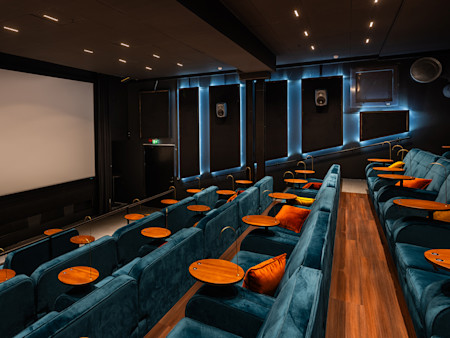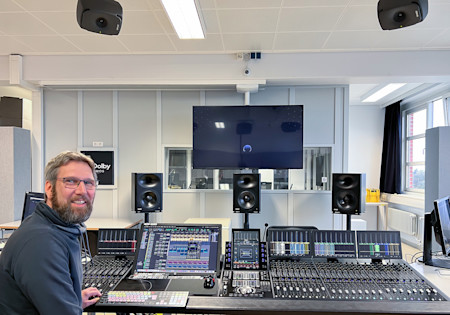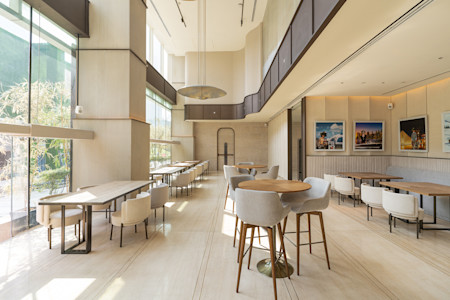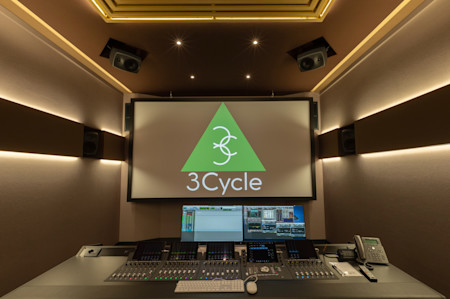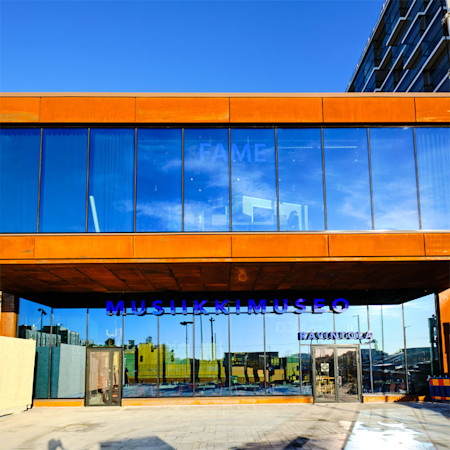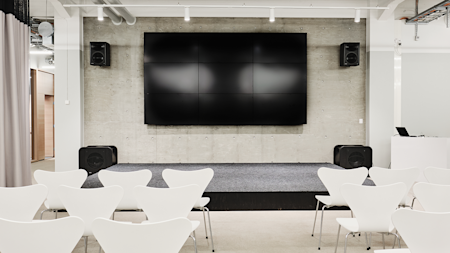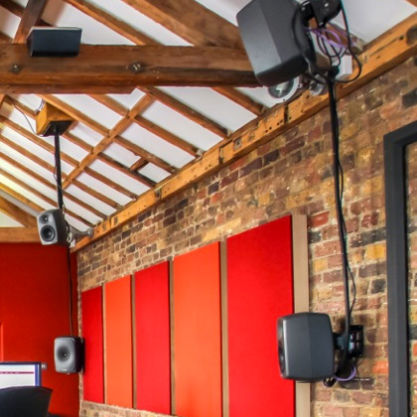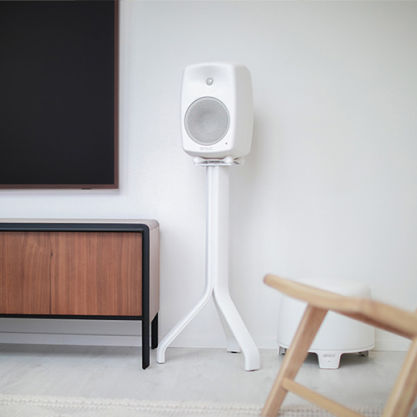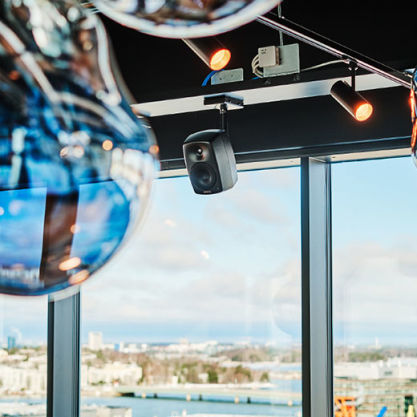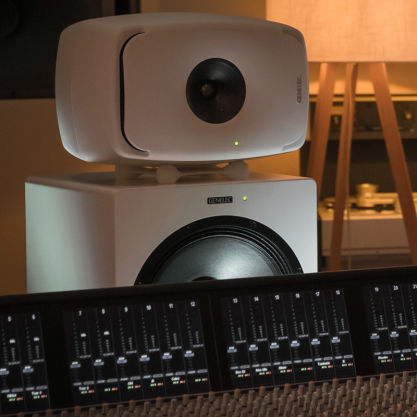The S360A delivers high SPL monitoring without compromising on predictability, speech intelligibility or sound quality.
S360
SAM™ Studio Monitor

Smart Active Monitoring (SAM™) and GLM™ calibration technology

Directivity Control Waveguide (DCW™) Technology

SPL
118 dB

Frequency Response
36 Hz - 22 kHz (-6 dB)

Dimensions
H 530 x W 360 x D 360 mm, with Iso-Pod™ (view in inches)

Loud and Clear
The S360A’s fusion of main monitor performance and compact size makes it perfect for demanding film, post and music production, and in combination with a subwoofer, the S360A satisfies the demands of EDM playback or Dolby film mixing even in rooms where the listening distance exceeds 10 metres (33 feet). Equally at home in free-standing, in-wall or on-wall positions, the S360A delivers neutral reproduction with a short-term SPL capability of 118 dB, with peaks even higher.
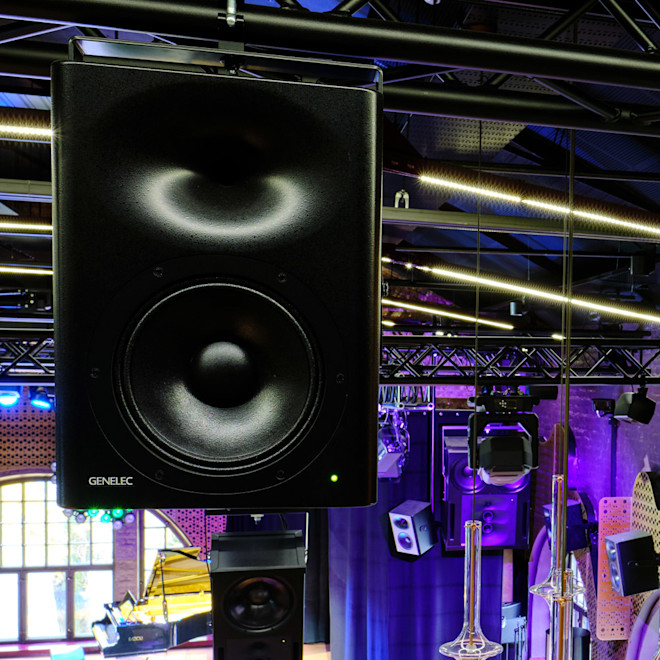
Calibrate for your environment
The S360A integrates closely with our GLM software via which it can be configured and calibrated for your listening environment, compensating for detrimental room influences to create a truly optimised monitoring solution from mono to immersive. Not only does help produce mixes that translate beautifully, but GLM also doubles as a comprehensive Mac or PC-based monitor controller, allowing you to calibrate your listening level to accepted loudness standards, switch between formats, monitoring systems and primary listening positions – and much more.
S360
Awards
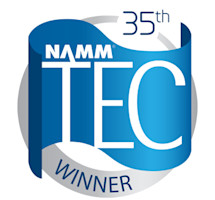
Now in its 35th year, the annual TEC Awards are widely recognized as the highest honour dedicated to the pro audio and sound recording industry. It’s where the most outstanding products in the worlds of music making, live performances, video games, television and films are recognised, and we were thrilled that our S360 and Aural ID were both voted winners for Outstanding Technical Achievement in their respective product categories.
This year was the first time that three companies all picked up double TEC awards, so congratulations also to our friends at Universal Audio and API for their success, and also to Joni Mitchell for being the deserved recipient of the Les Paul Innovation Award – presented by Herbie Hancock.
After a ‘Call for Entries’, the TEC Award nominations were made by a panel of professionals and thought leaders from all areas of the audio and sound production industries, and then voted upon by pro audio, live event and music industry professionals across the globe. The winners were then announced at a special awards dinner last Saturday - during the NAMM Show in California - and our team were on hand to step up and accept the awards.
The S360 high-SPL Smart Active Monitor triumphed in the Studio Monitors category, and has quickly become a benchmark for those working in music, film and post that demand a true reference that fuses main monitor performance with compact size – from stereo through to immersive formats.
By contrast, our Aural ID technology helps delivers a more truthful headphone listening experience by modelling the user’s personal head and upper torso features to produce a personalised file that then can be integrated into their audio workstation. This enables those in the worlds of music recording, post production, academic research, VR and games development to experience a far more natural sense of space and direction in their headphones, thus promoting more accurate and reliable headphone mixing.
Will Eggleston, our US marketing director commented “We thank all the voters who selected the S360 and Aural ID to win their respective categories. It is indeed an honour and a privilege to be recognised by our peers for the hard work of our R&D and engineering teams. They are incredibly outstanding products representing the spirit of innovation and market-driven development that Genelec strives to embody.”
Thank you to everyone that voted for us - we’re hugely proud, and grateful for your support!

We’d like to express our sincere gratitude to everyone that voted for our S360 high-SPL two way monitor, which has just been announced as the winner in the Monitoring category of Resolution Magazine’s prestigious 2019 awards.
Launched last summer at the AES Immersive Conference in Tokyo, the S360 is fast becoming an essential choice for both stereo music recording and immersive post-production, where the S360’s fusion of main monitor performance and compact size makes it perfect for those requiring precision listening at higher SPLs or longer listening distances.
Housed in a low diffraction enclosure with premium quality Finnish woodwork, the S360 features an enhanced 10-inch high efficiency woofer and 1-inch titanium diaphragm compression tweeter housed in an extended directivity control waveguide – delivering neutral reproduction with a short-term SPL capability of 118 dB, with peaks even higher.
As part of the growing Smart Active family of Genelec monitors and subwoofers, the S360 tightly integrates with GLM software, via which it can be configured, calibrated and controlled. Using GLM, any Genelec Smart Active model can be incorporated into a system configurable from simple stereo to high-channel count immersive formats.
Having been shortlisted by Resolution’s panel of industry experts and practitioners, voting was then opened to the magazine’s readers, social media followers, and the general public – who thankfully gave the S360 a resoundingly positive thumbs-up.
Once again thank you to everyone who supported us – we are extremely proud and grateful!
Technical Specifications

SPL
118 dB

Amplifier Power
250 W Bass (Class D) + 100 W Treble (Class D)

Frequency Response
36 Hz - 22 kHz ("-6 dB")

Accuracy of Frequency Response
± 2 dB (39 Hz - 19 kHz)

Driver Dimensions
⌀ 250 mm Bass + ⌀ 25 mm Treble (view in inches)

Dimensions
H 530 x W 360 x D 360 mm, with Iso-Pod™ (view in inches)

Weight
30 kg / 66.1 lb

Connections
1 x XLR Analog Input
1 x XLR AES/EBU Input
1 x XLR AES/EBU Output
2 x RJ45 Control
S360 SAM™ Studio Monitor
SAM™ Studio Monitor
Technical Specifications
The S360A delivers high SPL monitoring without compromising on predictability, speech intelligibility or sound quality.

System Specifications
Frequency Response
39 Hz - 19 kHz (± 2 dB)
Low cutoff -6dB
36 Hz
High cutoff -6dB
22 kHz
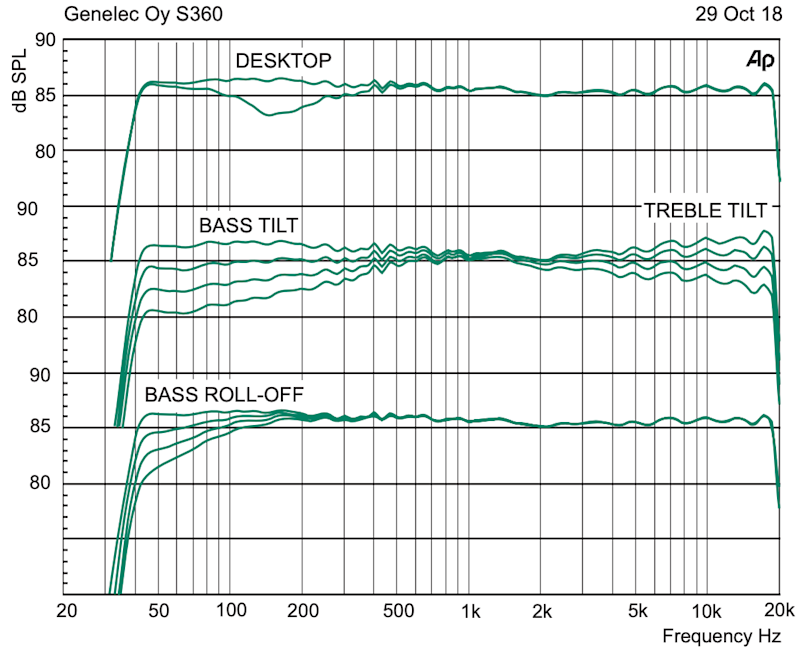
SPL
Peak SPL Maximum peak acoustic output per pair in a listening room with music material at 1 m.
≥128 dB
Short term max SPL Maximum short term sine wave acoustic output on axis in half space, averaged from 100 Hz to 3 kHz at 1 m.
≥118 dB
Long term max SPL Maximum long term RMS acoustic output in the same conditions with IEC weighted noise (limited by driver protection circuit) at 1 m.
≥112 dB
Self-generated noise
Self-generated noise Self generated noise level in free space at 1 m on axis (A-weighted).
≤10 dB SPL
Weight
Weight30 kg (66.1 lb)
Dimensions
Height
530 mm
Height with Iso-Pod
530 mm
Width
360 mm
Depth
360 mm
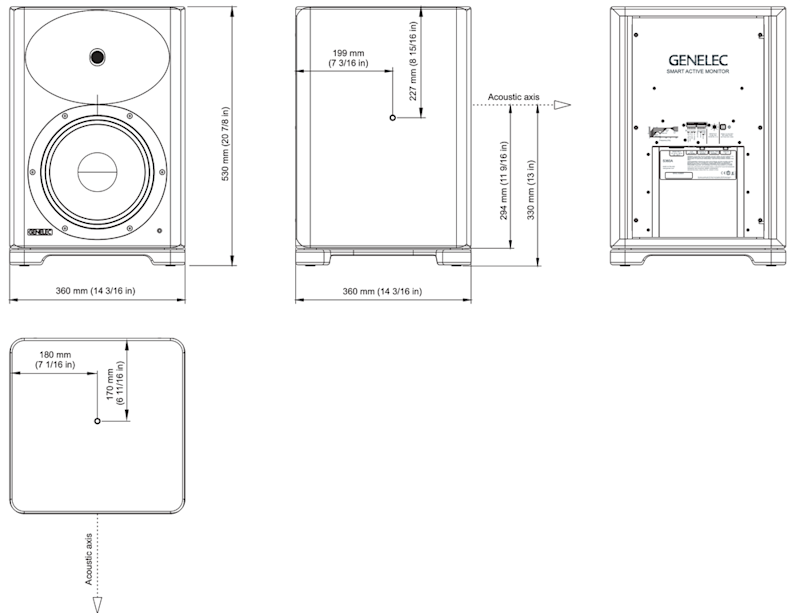
Enclosure
Enclosure material
MDF
Enclosure type
Reflex port
Drivers
Driver type
Cone
Diameter
250 mm
Driver type
Compression
Compression driver 44 mm (1.7 in) into a 25 mm (1 in) throat.
Diameter
25 mm
Directivity

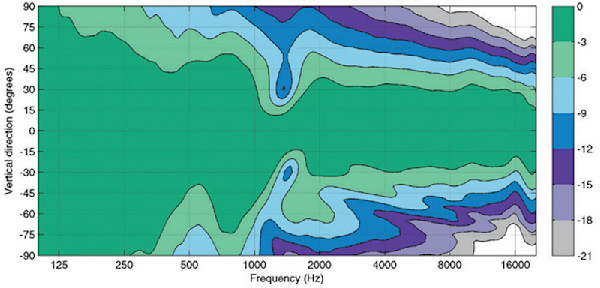
Harmonic distortion
100 Hz...5 kHz ≤0.5 %
> 5 kHz ≤1.5 %
Group delay
The latency at high frequencies from the input to the acoustic output, measured in the analog input:
Extended Phase Linearity in GLM set to OFF
5.2 ms
In Genelec performance graphics, the time of converting the from an electronic input signal to the acoustic output in a Genelec monitor is described by two factors – latency and group delay. The group delay factor can be read in the graphics for a specific frequency. The total frequency-specific input-to-output delay is a sum of the latency and group delay factors. To understand the significance of this total delay, consider that moving a loudspeaker away by 1 meter creates an additional delay of about 3 ms.
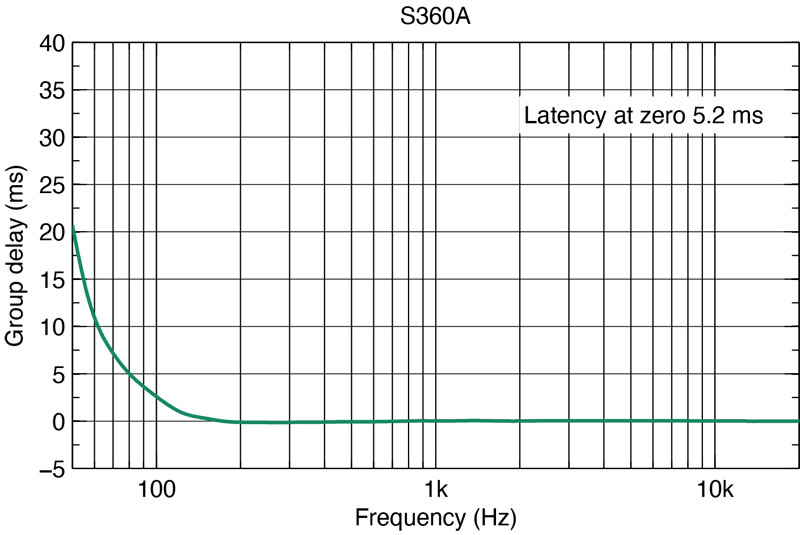
Amplifier Section
Amplifiers
250 W Class D
100 W Class D
Mains voltage
100-240 VAC 50/60Hz
Power consumption
ISS Active
≤1 W
Idle
≤11 W
Full output
230 W
Signal processing section
Connectors
Input Analog signal input connector XLR female, balanced 10 kOhm.
Input Digital signal input connector XLR female 110 Ohm.
Output Digital signal output / Thru connector XLR male 110 Ohm.
2 x Control Two CAT5 (RJ45) GLM Network connectors for computer control using the Genelec Loudspeaker Manager (GLM) software.
Product Variants
Product codes
Compatible Accessories
Product codes
For even more technical details please see product operating manual.
Key Technologies

Smart Active Monitoring (SAM™) and GLM™ calibration technology

Directivity Control Waveguide (DCW™) Technology

Active Crossovers

Intelligent Signal Sensing (ISS™) Technology

Laminar Integrated Port (LIP™) Technology

Protection Circuitry

Optimised Amplifiers

Room Response Compensation

Versatile Mountings
Networked Smart Active Monitor (SAM™) Systems feature automatic calibration to the environment.

Now, more than ever, audio productions are engineered in tighter, more confined working environments. This increases acoustic problems and lowers the reliability of monitoring. At the same time, an audio engineer's need to trust a reliable and precise monitoring system that reproduces sound neutrally and without distortion has not changed.
Built upon the solid electro-acoustic foundations of our 1200, 8000 and 7000 Series products, Genelec SAM Systems are today’s most advanced and flexible monitoring solutions. They are an indispensable tool for audio professionals, as they automatically adapt to the acoustic environment and correct for level, delay and room anomalies. SAM Systems are controlled using Genelec's proprietary Loudspeaker Manager (GLM™) network and software, enabling you to build a highly flexible and reliable monitoring system.
GLM is a highly intuitive and powerful monitor control networking system that manages connectivity to all SAM studio monitors and subwoofers on the network. GLM software features adjustment of level, distance delay and flexible room response compensation equalisation with our state-of-the-art, highly robust AutoCal™ 2 algorithm automated calibration system. All parameters and settings are stored in system setup files or saved in each individual monitor or subwoofer, if the GLM network needs to be disconnected.
Also, all acoustical features of SAM Systems can be optimised and tailored for different working styles or client demands. Additionally, even if the monitors or the production projects move between rooms, you can expect SAM technology to provide the highest consistency in monitoring, providing neutral soundstage imaging with low distortion – in each environment.
Genelec SAM Systems offer a comprehensive, solution-oriented, intelligently networked product range supporting analogue and digital signals in virtually any working environment.
Directivity Control Waveguide (DCW™) for flat on and off-axis response.

A revolutionary approach was taken by Genelec in 1983 with the development of its Directivity Control Waveguide (DCW™). We have developed and refined this technology over more than 30 years to greatly improve the performance of direct radiating multi-way monitors.
The DCW technology shapes the emitted wavefront in a controlled way, allowing predictable tailoring of the directivity (dispersion) pattern. To make the directivity uniform and smooth, the goal is to limit the radiation angle so that the stray radiation is reduced. It results in excellent flatness of the overall frequency response as well as uniform power response. This minimises early reflections and provides a wide and controlled listening area achieving accurate sound reproduction on and off-axis.
Minimised early reflections and controlled, constant directivity have another important advantage: the frequency balance of the room reverberation field is essentially the same as the direct field from the monitors. As a consequence, the monitoring system's performance is less dependent on room acoustic characteristics.
Sound image width and depth, critical components in any listening environment, are important not only for on-axis listening, but also off-axis. This accommodates not only the engineer doing their job, but also others in the listening field, as is so often the case in large control rooms.
DCW™ Technology key benefits:
- Flat on and off-axis response for wider usable listening area.
- Increased direct-to-reflected sound ratio for reduced control room coloration.
- Improved stereo and sound stage imaging.
- Increased drive unit sensitivity up to 6 dB.
- Increased system maximum sound pressure level capacity.
- Decreased drive unit distortion.
- Reduced cabinet edge diffraction.
- Reduced complete system distortion.
Active crossover operating at low signal levels.

Audio electronic crossovers allow the audio signal to be split into separate frequency bands that are separately routed to individual power amplifiers, which are then connected to specific transducers optimised for a particular frequency band.
Active crossovers come in both digital and analogue varieties. Genelec digital active crossovers include additional signal processing, such as driver protection, delay, and equalisation.
Genelec analogue active crossover filters contain electronic components that are operated at low signal levels suitable for power amplifier inputs. This is in contrast to passive crossovers that operate at the high signal levels of the power amplifier's outputs, having to handle high currents and, in some cases, high voltages.
In a typical two-way system the active crossover needs two power amplifiers — one for the woofer and one for the tweeter.
The active crossover design offers multiple benefits:
- The frequency response becomes independent of any dynamic changes in the driver's electrical characteristics or the drive level.
- There is increased flexibility and precision for adjusting and fine-tuning each output frequency response for the specific drivers used.
- Each driver has its own signal processing and power amplifier. This isolates each driver from the drive signals handled by the other drivers, reducing inter-modulation distortion and overdriving problems.
- The ability to compensate for sensitivity variations between drivers.
- The possibility to compensate for frequency and phase response anomalies associated with a driver’s characteristics within the intended pass-band.
- The flat frequency response of a high-quality active loudspeaker is a result of the combined effect of the crossover filter response, power amplifier responses and driver responses in a loudspeaker enclosure.
Using the active approach enables frequency response adjustments and optimisation of the full loudspeaker system, placed in various room environments, without expensive external equalisers. The end result is a simpler, more reliable, efficient, consistent and precise active loudspeaker system.
Intelligent Signal Sensing (ISS™) for power consumption reduction in stand-by mode.

Introduced early 2013, Genelec’s Intelligent Signal-Sensing technology has been developed to meet with both European Union ErP Directives and Genelec's own ambitious sustainability standards.
The Intelligent Signal Sensing, ISS™ circuitry tracks the signal input of the loudspeaker and detects if it is in use. If the ISS circuit does not find any audio on the input for a period of time, it sets the loudspeaker to a low-power sleep state and the loudspeaker will consume less than 0.5 watts. When an input signal is detected, the loudspeaker immediately turns itself on.
Additionally an ‘ISS Disable’ switch is located on each product’s back plate next to the other room response controls. First, when the mains power switch of the loudspeaker is set to 'ON', the ISS™ auto-start function (low-power sleep state on/off) of the loudspeaker is active.
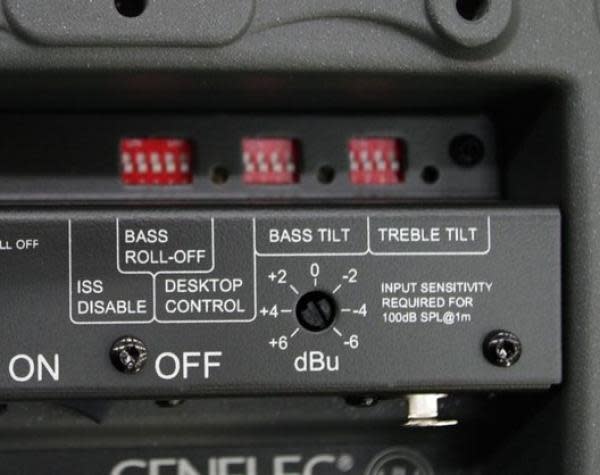
If this function is not desired, the ISS™ function can be disabled by setting the 'ISS Disable' switch on the back panel to 'ON' position. In this mode, the monitor is only powered on and off using the mains power switch.
Note that the mains power switch will always turn the monitor off completely.
Laminar Integrated Port (LIP™) allows for precise bass reproduction.

Genelec’s choice for vented (or bass reflex) enclosures dates back to 1978 and the first active monitor developed by Genelec, the S30. Research to improve the performance and efficiency of reflex ports has been pursued ever since.
A typical reflex port enclosure features a tube and an opening area. To avoid turbulences in the tube the air flow should not meet any acute angles as this would generate noise, compression, distortion and losses of the total radiated energy. To minimize the air flow speed, both the tube and its cross section have to be large. Often, the outer enclosure dimensions become a limitation, because a long tube will not fit in the available volume anymore.
The M Series features two vent tubes having opening stretching across half of the enclosure depth to address these specific issues. The novel patent-pending Laminar Integral Port, LIP™, has been flow-optimized using computer-based finite element models to achieve low distortion and high efficiency even at very high audio output levels.
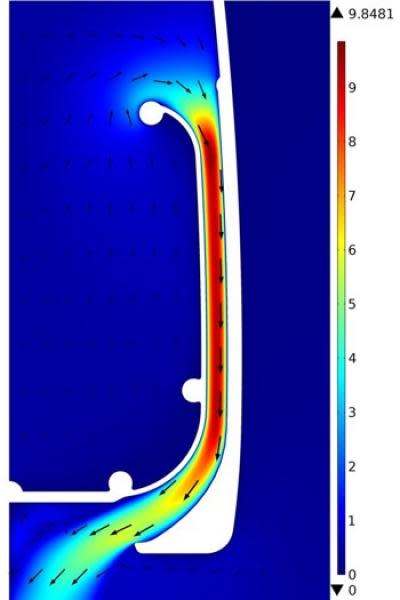
The reflex ports are integrated in the NCE enclosure during the moulding process, avoiding the need for separate additional components. The cross-section plot (Figure) demonstrates the efficient flow characteristics of the port. The natural installation orientation of the M Series is vertical and to allow easy placement of the monitor against a wall, the M Series ports opening face downwards, in the space under the monitor.
The novel Laminar Integrated Port, LIP™, bass reflex system provides accurate low frequency response and faithful tonal reproduction characteristics.
Sophisticated drive unit protection circuitry for safe operation.

When working in critical audio production environments it is essential that monitoring systems remain reliable and functional at all times. One of the main reasons behind Genelec’s excellent success in broadcasting environments is the reliability of our products and a key element behind the reliability is the internal protection circuitry found in all products since 1978.
The protection circuitry prevents driver failures by detecting signal levels, and in case of sudden peaks or constantly too high levels, taking the signal level down automatically. Of course this feature does not affect the sound quality in any way when working within the specifications of the loudspeaker, but only prevents inadequate input signals from breaking the loudspeaker.
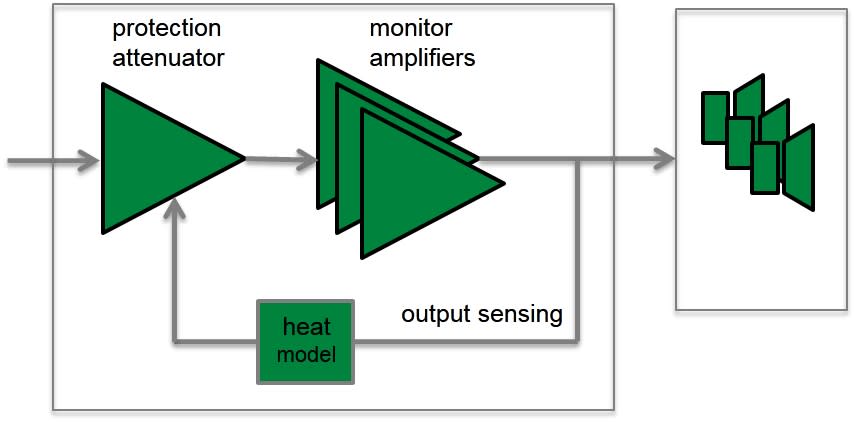
Protection circuitry features and benefits:
- Reduces the output level when required, (e.g. when driver voice coil temperature reaches the safe limit), which highly improves system reliability.
- Appropriate protection circuitry design in every loudspeaker and subwoofer enables the maximisation of system output sound level.
Each transducer is driven by its own optimised amplifier.

Audio electronic crossovers allow to split the audio signal into separate frequency bands that can be separately routed to individual power amplifiers, which are then connected to specific transducers optimised for a particular frequency band.
In a typical 2-way loudspeaker system, the active crossover needs two power amplifiers — one for the woofer and one for the tweeter. The power amplifiers are connected directly to the drivers of an active loudspeaker, resulting in the power amplifier’s load becoming much simpler and well known. Each driver-specific power amplifier has only a limited frequency range to amplify (the power amplifier is placed after the active crossover) and this adds to the ease of design.
The active design principle offers multiple benefits:
- The power amplifiers are directly connected to the speaker drivers, maximising the control exerted by the power amplifier’s damping on the driver’s voice coil, reducing the consequences of dynamic changes in the driver electrical characteristics. This may improve the transient response of the system.
- There is a reduction in the power amplifier output requirement. With no energy lost in the passive crossover filter components, the amplifier power output requirements are reduced considerably (by up to 1/2 in some cases) without any reduction in the acoustic power output of the loudspeaker system. This can reduce costs and increase audio quality and system reliability.
- No loss between amplifier and driver units results in maximum acoustic efficiency.
- Active technology can achieve superior sound output vs. size vs. low frequency cut-off performance.
- All loudspeakers are delivered as a factory aligned system (amplifiers, crossover electronics and enclosure-driver systems).
Precise room response compensation for optimizing in-room performance.

The interaction between room acoustic and loudspeaker radiation is complex. Each room changes somewhat the monitor’s response in a unique way, e.g. reflective vs. damped rooms, or placement against a wall vs. on a stand away from the walls.
All Genelec loudspeaker systems feature room response adjustments to compensate for the room influences and retrieve a flat frequency response at the listening position.
Analogue Systems
Genelec analogue loudspeaker systems provide versatile Room Response Controls. They include (depending on models):
- Bass Roll-Off and Bass Tilt
- Treble Tilt and Treble Roll-Off
- Bass Level
- Midrange Level
- Treble Level
- Desktop Control

At low frequencies two main controls are provided. The Bass Tilt control, which acts as a shelving filter together with the Bass Roll-off control allowing you to optimize the low and very low frequency response of the system in different installations. Bass, midrange and treble level controls are provided in large systems. These controls allow to optimize the relative balance between the various pass bands.
The operating manual and datasheet of each loudspeaker contains a list of preferred room response control settings for different installations. These have been specified out of long practical experience and measurements of various kind of typical acoustic environments.
Smart Active Monitor (SAM™) Systems
Genelec SAM Systems offer a comprehensive, solution-oriented, intelligently networked product range which all feature Genelec Loudspeaker Manager (GLM™) software and its automatic calibration system called AutoCal™.
Genelec AutoCal provides the industry’s first integrated process for complete automated measurement, analysis, and adjustment of every monitor on the GLM control network. The system measures the response in the listening area and applies relevant compensation in the low and low-mid frequencies to minimise the detrimental room acoustic anomalies as well as the differences between various listening positions. AutoCal also aligns relative levels, time-of-flight, as well as adjusts correct crossover phase (called AutoPhase) for all subwoofers on the network.

The Acoustic Response Editor provides accurate graphical display of the measured response, filter compensation and the resulting system response for each monitor, with full manual control of acoustic settings.
Versatile mounting options for all installation needs.

In addition to perfect acoustical design and advanced tailoring options to optimize the loudspeaker’s behaviour to the room environment, Genelec loudspeakers offer a variety of mounting options for easy installation in different applications.
Our wide range of accessories and fixed mounting points on the back of our aluminium enclosure products offer solutions to all common installation situations. M6 support points have been integrated in the die-cast enclosure for wall and ceiling mounts.
Some models also feature a 3/8” thread at the bottom of the enclosure to fit a robust microphone stand. Other larger and heavier models feature M10 fixing points. Special floor stand plates have been designed in order to fit the Iso-Pod stand that is part of our product design.
With these features our loudspeakers have found their way to a variety of applications beyond the professional audio and studio world, for example in commercial and AV installation projects as well as in home environments all around the world.
References
Genelec UNIO Explained | How the ecosystem offers seamless in-room and personal headphone monitoring
One on One with Jonathan Wilson
Genelec UNIO Explained | How the ecosystem offers seamless in-room and personal headphone monitoring
A quick guide to our UNIO Ecosystem – which offers audio engineers seamless bridging of in-room and personal headphone monitoring. https://genelec.com/UNIO
The Genelec UNIO Ecosystem – which combines the power of our renowned GLM, SAM Monitoring and Aural ID adaptive technologies – gives audio engineers the flexibility to work anywhere, anytime, from stereo to immersive. And now, with the new UNIO Personal Reference Monitoring (PRM) solution, audio professionals benefit from the pinpoint accuracy of our pioneering active monitoring headphone solution, which combines the 9320A SAM Reference Controller with uniquely factory-calibrated 8550A Professional Reference Headphones.
To learn more, visit https://genelec.com/UNIO

